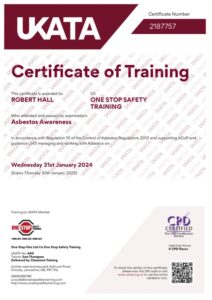We take care of your build
If so, you’ll be in safe hands with Adamson’s. Got a question, want an idea of price or ready to book your FREE home design visit?
Despite the Asbestos ban in 1999, asbestos exposure is the largest cause of construction work-related deaths in Great Britain, killing over 5,000 workers a year.
Due to there being decades of delay between exposure and the symptoms of the disease appearing, we need to make our younger generation aware that it isn’t only the older generation who can be affected, as it is still around in many homes today, where we are introducing more apprentices each year.
In a plea to spread awareness of Asbestos in the Construction Industry, The Health and Safety Executive launched a campaign early in 2023, knowing that it still poses a real issue to trades at any age.
Dealing with Asbestos during a home renovation is critical and requires caution and adherence to safety guidelines to minimise health risks, as once disturbed, the tiny particles that cannot be seen, smelt, or felt will be released and can prove fatal if breathed in, causing lung disease and cancer.
There are several safety steps to take before any renovation, and we offer our guidelines to help you.
If your house was built before the year 2000, there is a higher likelihood of Asbestos being present.
Always call a professional Asbestos Inspector to conduct a thorough inspection to assess if there is Asbestos present in the area of the home you are renovating.
Adamsons’ has regularly trained staff that can identify the presence of Asbestos and will follow all guidelines and procedures accordingly.
 Asbestos Certificate of Training for Adamsons
Asbestos Certificate of Training for Adamsons
It is critical to consult with professionals trained and experienced in asbestos removal and not to try to handle asbestos-containing materials yourself.
Hiring licensed asbestos removal professionals to assess the situation to carry out the necessary removal procedures will keep you and your family safe
Talk with your builder to develop a renovation plan that takes into account the presence of asbestos.
This may involve adjusting the renovation schedule and design to minimise disturbance to asbestos-containing materials.
The convenience and hygiene of a temporary functional bathroom require thoughtful planning. Talk to your builder about all the options available.
Water access, shower alternatives, and toilet facilities (even if they are portable) within your home before construction starts will be critical to your well-being.
Always ensure that the renovation area is isolated to prevent the spread of asbestos fibres to other parts of the house, and use thick plastic sheeting and tape to seal off the work area.
Avoid activities that could disturb asbestos-containing materials unnecessarily, including sanding, drilling, or cutting without proper precautions.
Using wet methods will minimise the release of asbestos fibres, which involves spraying surfaces with water before working on them to suppress dust.
Asbestos is a killer, and it can be in many places around your home, including:
* Roofing Felt
*Partition Walls
*Loose Fill Insulation
*Cement Water Tanks
*Ceiling Artex
*Toilet Cisterns
*Fuse Boxes and Fuse Boards
*Airing Cupboards
*Insulation Coating on Hot Water Tanks
*Downpipes & Pipe Lagging
*Gas/Electric Meter Boxes
*Vinyl Floor Tiles
*Etc.
Prioritising health and safety by using adequate personal protective equipment, proper containment, and appropriate removal techniques will minimise the risk of asbestos exposure to all involved.
But when in doubt, call the professional out.
It’s always better to be safe than sorry.
